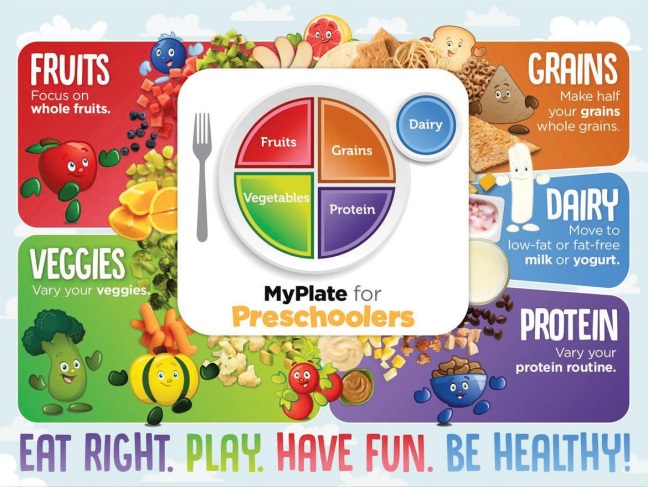Filling out the bingo card throughout the week can get a Healthy Eating Bingo! In areas with accessible farms, individuals might develop a connection to foods from a visit to a nearby farmers' market to see the varieties of fruits and vegetables or to a pick-yourown farm. Outings and trips can increase exposure and help build positive associations to new and healthy foods. For someone who has never before tried a strawberry, a trip to see where the food grows and handling that food is the first step toward trying it.

RIGHT APPETITE: Research has shown that adding pictures to written or spoken health education materials increases the students' comprehension. This poster is based on the USDA's MyPlate recommendations.
"Taste Tests" are another way to increase exposure to foods and allow individuals to describe their experience of the food. Taste tests can be set up for different types of apples or pears picked from an orchard or from a grocery-store trip. Individuals can be asked to describe the difference in taste (tart, sweet, bitter), texture (crunchy, smooth, mushy) and take notes next to each type. Originally intended for children, the USDA offers a "Kids Food Critic" handout that can be adapted for all ages and groups where they can draw a food they are tasting, rate it by visual appeal, smell, taste and texture, and then give it a total score.3 For those with sensory preferences, strategizing with a feeding therapist first is beneficial.
When there are no contraindications, including an individual in meal preparation is fundamental. Among youths, helping to prepare meals is associated with healthier eating behaviors, and helping at home with meal preparation has been demonstrated to be associated with improved overall diet quality, eating more fruits and vegetables and potentially with consuming more grains, meat and meat alternatives and milk and milk alternatives.4 For individuals where a hot oven or handling a knife is not feasible, they might choose recipes, gather ingredients and kitchen tools, wash vegetables, measure and stir ingredients and help set the table. Introducing an individual to a kitchen starts with safety and sanitation, where hand washing and the dangers of knives and kitchen equipment are reinforced.
Finding healthy recipes to prepare and sharing why the recipes
were chosen will help fortify nutrition concepts. There may be stories or books related to a major ingredient in the recipe to read aloud or share beforehand. Along with meal preparation, being involved with meal planning can help individuals develop self-efficacy and confidence in making healthy food choices. Individuals can plan a dinner and make sure the meal is balanced with a protein, vegetable, fruit, and grain or starchy vegetable. They can aid in planning the grocery shopping list and by making sure there are enough vegetables to serve for the week's dinners. Lastly, tending to a small vegetable garden or growing some herbs on the windowsill to use in home-cooked recipes can be fulfilling for a family or housemates living in a group residence. As they become acclimated to inclusion, there are endless ways individuals can participate in food related activities.
Trying and handling different foods can be very difficult for some children with I/DD or autism, especially for those that have Sensory Processing Disorder. While an individual may grow out of limited eating, some individuals maintain a restricted palate through adulthood. Individuals may favor certain textures or temperatures over others, so introducing new foods or recipes within those parameters can increase acceptance (ex. crunchy, creamy, cold, etc). Avoiding too many new textures at once and loud kitchen equipment can also be helpful.
Given the heavy load shouldered by caregivers, finding time for nutrition activities can be difficult, but even planning one nutrition activity per month around one important and practical nutrition goal can make a difference. Seek advice and resources from your healthcare team, including a Registered Dietitian. When time is limited and accessing visual and print resources is not an option, you may still request them from a Registered Dietitian or Feeding Therapist. Teaching an individual basic nutrition information will decrease their risk of chronic illness and help them feel their best. With clear nutrition messages imparted through enjoyable activities appropriate for one’s age and individual needs, we can respectfully provide those in the I/DD community the knowledge to make healthy choices for themselves.
ABOUT THE AUTHOR:

Jenny Torino is a Registered Dietitian with over 15 years experience in the field. She is currently working with individuals with I/DD at the ARC in Sussex County, NJ. She has also held positions as an outpatient dietitian at the VA Medical Center and a private nutrition practice in Providence, Rhode Island. She initially started her career at GMHC, the nation's first HIV/AIDS service organization in New York City. She holds her Masters Degree in Clinical Nutrition from New York University.
References
- "Raise a Child Who is a Joy to Feed: Follow the Ellyn Satter Division of Responsibility in Feeding" Ellyn Satter: ellynsatterinstitute.org/how-to-feed/the-division-of-responsibility-in-feeding, Accessed 1/20/22.
- Houts, P.S., C.C. Doak, L.G. Doak, and M.J. Loscalzo 2006. "The role of pictures in improving health communication: A review of research on attention, comprehension, recall and adherence." Patient Education and Counseling 61:173-190.
- U.S. Department of Agriculture. ChooseMyPlate.gov Website. Washington, DC. myplate.gov. Accessed January 27, 2022.
- Quelly, S.B. PhD, RN, CNE, "Helping with Meal Preparation and Children's Dietary Intake: A Literature Review," The Journal of School Nursing, 2019, Vol. 35(I) 51-60.9